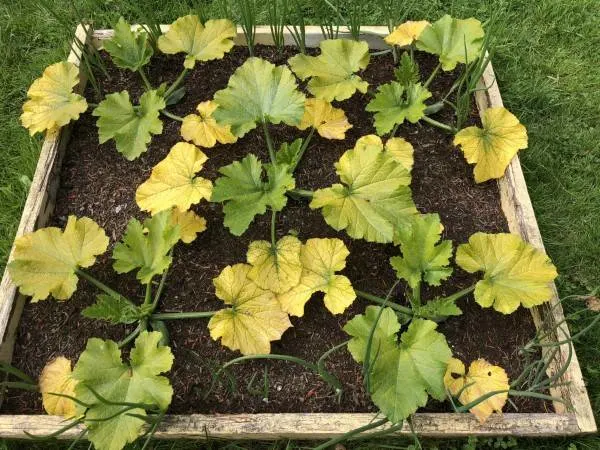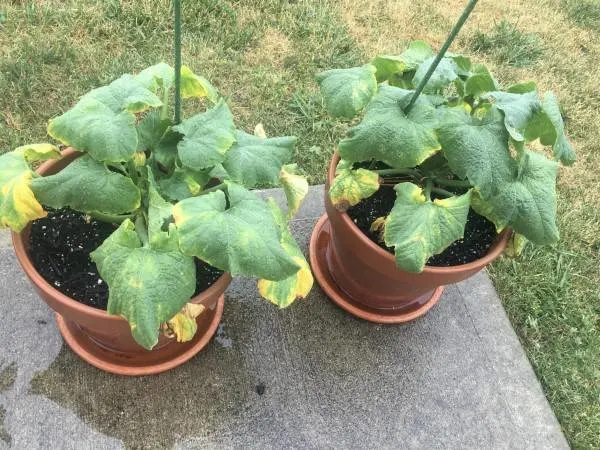Summer squashes like pattypan, globe squash, and zucchini are usually relatively easy to plant and grow. That said, from time to time, gardeners will face struggles with these productive crops.
Sometimes the fruits will come out deformed and undersized, or your vines will stop producing mid-summer. And other times, you’ll find yourself wondering the same thing you’re pondering today; “Why are my zucchini leaves turning yellow?”
If the zucchini growing problem has struck your garden, this guide could be the solution you were scouring the internet for.

Why Are My Zucchini Leaves Turning Yellow?
Over the long term, as you pursue your zucchini farming hobby or business, you’re bound to deal with leaves that are dying or turning yellow. So, when you spot this clear indication of a problem with your plants, DO NOT panic! Remember that every gardener experiences this from time to time.
Next, start thinking like a doctor and ask the right questions. First, note that all things that kill plants can be broken into two categories, biotic and abiotic. Abiotic implies that environmental conditions are responsible, while biotic points towards living organisms that can act as pathogens.
Usually, if you’re dealing with abiotic agents like insect herbivory or fungal diseases, there’ll be specific symptoms around your gardens, like insect trails or holes on the leaves. Fungi may also cause spots, eventually resulting in powdery spores on the zucchini leaves’ surfaces.
So, after finding the culprit category behind your yellow zucchini leaves, it’s time to use the process of elimination to ascertain which of the following could be the main reason.
1. Poor Soil Nutrients
Zucchini vines are heavy feeders and will constantly crave vital NPK soil nutrients. The N stands for nitrogen, P for phosphorus, and K for potassium.
For those who don’t know NPK’s importance to plants, potassium promotes fruiting and flowering, phosphorus promotes root and shoot growth, while nitrogen promotes vegetation and leaves growth.
With that in mind, if you’ve planted your zucchini in pots or containers, chances are they have quickly exhausted all the nutrients in the soil manure.
This is a fundamental lesson that every first-time container grower needs to learn. Since the plants have a limited dirt supply, you will need to use fertilizers to replace the soil nutrients routinely.
To effectively, quickly, and organically treat your zucchini plant, use bat guano every 3 or 4 days until the leaves shift from their yellow shade to a lovely, healthy green.
2. Damaged Roots
Zucchini vine roots are extremely sensitive, and even the slightest damages to these roots’ systems could make your zucchini’s leaves start turning yellow.
If the vine’s roots have been utterly damaged, there isn’t a lot anyone can do to rectify the situation. If not, however, try and avoid stressing the vines any further.
To avoid damaged roots altogether, work as hard as you can during the planting season to protect the zucchini’s garden. What’s more? Refrain from any transplanting efforts as much as possible, and do not let anyone or anything stand close to the plant’s base.
These little efforts to protect your zucchini’s roots compound well and will reward you with a yield so bountiful you’ll have more than enough to stockpile for the upcoming winter. This brings me to the next probable cause.

3. Insufficient Sun
The sun is crucial for every plant’s survival, and zucchini vines are no exception. They need as much sun as possible to grow healthy and stay productive.
As such, ensure your zucchini are placed in an area they can receive at least six hours of sunlight every single day. Finding a spot that receives eight hours a day is even better.
But what if you already planted your zucchini, and it wasn’t until they were fully grown that you realized you had picked the wrong spot? Well, the only way to fix this predicament is to transplant the zucchini to a different, better location.
I know we just highlighted that transplanting these vines isn’t ideal as it can damage the roots, but you might as well take the chance because leaving them at their current location means certain death.
4. Underwatering or Overwatering
Ensure your zucchini vines get at least an inch of water every week. On weeks without rainfall, you’ll need to water them deeply at least once to reach that threshold.
Another way to determine if you’re underwatering your zucchini is to dig approx. 4 inches into the soil next to the vines. If you notice the soil is dry, the plants need watering.
Note, though, that overwatering your zucchini is just as dangerous as underwatering because it stunts their growth by drowning their roots. The best way to ensure this doesn’t happen is to confirm the soil is parched before watering the plants again.
5. Improver Zucchini Variety Selection
Like all other things, zucchini varieties aren’t created to perform the same. Depending on the season or where you live, some of them will be more pest and disease resistant than others.
With that in mind, when picking the zucchini variety for your garden, ensure you go only for those that are pest and disease resistant.
Zucchini varieties with high resistance levels include Yellow Fin, Burpee Golden Glory, Green Machine, and Tigress.
>> Related Posts:
- Why Are My Zucchini Turning Yellow? 4 Tried and Tested Solutions!
- How To Stake Zucchini in 10 Simple Steps – A Step by Step Guide
- How To Save Zucchini Seeds – 5 Steps Guide
Final Thoughts
Gardening presents constant challenges, and you’ll need to stay prepared for any sorts of problems that might pop up. As such, your best bet in dealing with white and yellow spots in zucchini leaves is to employ all the tips I’ve shared above and put preventative measures in place before planting.
Preventive measures that are a must, include inviting good bugs, giving your vines total sun exposure, practicing crop rotation, watering them just the right amount, and ensuring the soil you plant them on is well-draining and rich in nutrients.
Remember: The more time you dedicate to tending to your zucchini seeds, the less likely you’ll be to deal with dying plants or yellow leaves in the future.
